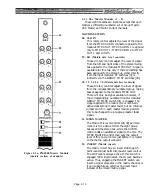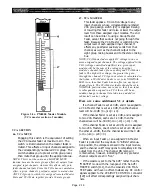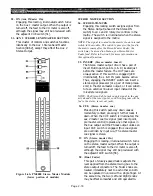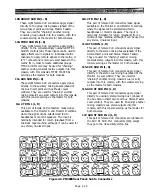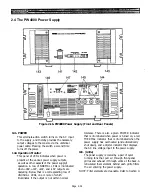
2.2 PM4000 Rear Panel Features
All XLR connectors and phone jacks are balanced.
Outputs and patch points are +4 dBu level unless
otherwise noted. Channel inputs, sub inputs, sub
outputs, and primary outputs all rely upon XLR-3 type
connectors wired Pin 2=high, Pin 3=low, Pin 1=ground.
INSERT IN/OUT points are ¼" (6.33mm) tip/ring/
sleeve configuration, wired tip=low, ring=high,
sleeve=ground.
Input channel XLRs are electronically balanced, as
supplied. Optional input isolation transformers may be
installed on a module-by-module basis; see Section 6.
Output XLRs are also electronically balanced. Optional
output isolation transformers are available in an
external 19-inch rack mount package housing eight
transformers. In this way, inputs and outputs can be
provided with extra grounding isolation and common
mode rejection where required, but one need not pay the
price in direct costs, weight or signal quality where the
transformers are not needed.
MONO INPUT MODULE INPUT STRIPS
101. INPUT (connector)
This electronically balanced, female XLR-3
connector applies signal to the correspondingly
numbered input channel. The nominal input level
may vary from -70 dBu to +4 dBu depending on the
settings of the channel input gain control and 30
dB pad switch.
102. INSERT OUT, INSERT IN (Jacks)
These phone jacks serve as a patch point for the
signal from the correspondingly numbered input
channel. Nominal output and input level is
+4 dBu (1.23 V).
The OUT jack may be used as an auxiliary output
to another console or as a direct output to a
multitrack tape machine, although a separate
DIRECT OUT jack is provided for this purpose
[103]. It is most often likely to be used for sending
the input channel signal to an auxiliary signal
processor (compressor, graphic EQ, noise gate,
etc.). INSERT OUT is always “live” whether or not
the channel is on.
The IN jack applies signal to the input channel and
is “normalled” so that inserting a plug interrupts
the internal signal flow through the channel,
instead bringing in the return from an auxiliary
signal processor. However, there is an INSERT on/
off switch in each channel [16] which can bypass
the INSERT IN jack, regardless of whether an
external source is plugged in or not.
NOTE: The insert patch point is nominally derived
post-EQ, pre-Fader. When the Insert PRE switch is
engaged [15], that point changes to pre-Fader and pre-
EQ, just after the gain control, pad and polarity switch.
103. DIRECT OUT (Jack)
This phone jack outputs the correspondingly
numbered input channel signal from a point just
after the fader. However, an internal jumper
switch in the module may be set to change the
direct output to a point pre-EQ and HPF filter, but
after the pad and gain control. See Section 6 for
details.
Figure 2-8. PM4000 Rear Panel:
Mono Channel Input Strip
Page 2-27
Summary of Contents for PM4000
Page 1: ...PROFESSIONAL AUDIO MIXING CONSOLE PM4000 OPERATING MANUAL YAMAHA ...
Page 2: ...PM4000 OPERATING MANUAL ...
Page 7: ...Section 1 Introduction ...
Page 11: ...Section 2 Brief Operating Instruction ...
Page 47: ...Section 3 Specifications ...
Page 51: ...Dimensional Drawings PM4000 Console all versions Page 3 4 ...
Page 52: ...Page 3 5 ...
Page 53: ...Page 3 6 PM4000 Console Rear Profiles ...
Page 54: ...Module Block Diagrams See back of the manual for overall system block diagram Page 3 7 ...
Page 55: ...Page 3 8 ...
Page 56: ...Page 3 9 ...
Page 57: ...Page 3 10 ...
Page 58: ...Page 3 11 ...
Page 59: ...Page 3 12 ...
Page 60: ...Section 4 Installation Notes ...
Page 72: ...Figure 4 13 Cables For Use With Balanced Sources Page 4 12 ...
Page 79: ...SECTION 5 Gain Structure and Levels ...
Page 82: ...Figure 5 1 Dynamic Range and Headroom in Sound Systems Page 5 3 ...
Page 86: ...Section 6 Optional Functions ...
Page 106: ...Section 7 Operating Notes and Hints ...
Page 119: ...Section 8 Applications ...
Page 127: ...Section 9 Maintenance ...
Page 131: ......
Page 132: ...YAMAHA VN02300 ...

